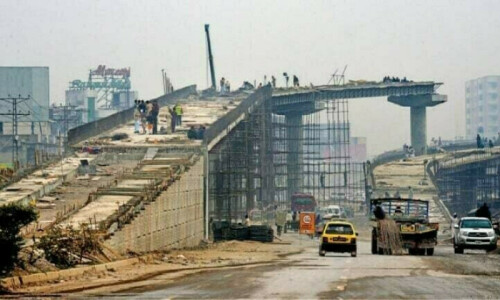KARACHI, June 15: The Sindh’s GDP has been estimated at $40 billion by the Sindh Senior Minister, Syed Sardar Ahmad, in his budget speech who called it the second largest economy of Pakistan.
At this estimate of $40 billion (Rs240 billion), Sindh’s economy is roughly a little more than 27 per cent of the national economy and has apparently slipped down from 33 to 34 per cent of the national economy during the decades of the 60s, 70s and even during a part of the 80s. The federal ministers put national economy at $146 billion (Rs8,760 billion) in 2007 and hope to push it up further by seven per cent plus during 2007-08.
But the senior minister in his speech did not elaborate further on Sindh’s regional domestic production to inform public of the contribution of various components of the economy indicating that the $40 billion estimate was a mere guesstimate rather than the result of a serious exercise. There is not a word on industrial growth, agricultural production, services sector, mining, fisheries, livestock, schools, hospitals, enrollment of children, particularly of girls in schools.
A day earlier, the Punjab chief minister had informed public that Punjab’s GDP was 53 per cent of Pakistan’s economy and that it showed a growth of eight per cent plus during 2006-07.
By implication, the Punjab chief minister made it known to all that economic growth of his province was well above the national average growth of seven per cent. It means that the three other provinces are far behind in development and Punjab is the growth engine of Pakistan’s economy.
By this estimation, (Punjab’s share of 53 per cent and Sindh’s 27 per cent), the share of the other two provinces, Balochistan and NWFP, comes to a mere 20 per cent. There is no study to show how much is the share of each of the two provinces — Balochistan and NWFP — in 20 per cent.
Punjab has developed a mechanism of monitoring GDP indicators with the assistance of World Bank and has found that quite a good size of Sindh’s services sector shifted to Lahore. Services sector in Punjab was estimated at 53 per cent of its total economy in 2005. Investment and industrial growth in Punjab has been crawling up in Punjab since the 1977 takeover by General Ziaul Haq. Agricultural growth in Punjab has been steady than in Sindh because of better availability of water.
The World Bank too carried out a study on Sindh’s economy after the 2002 elections and formation of a coalition government in Karachi.
The findings of the World Bank team in more than two years’ exercise was not well taken by the political leadership and bureaucrats of Sindh.
Well-placed sources in Sindh explained that the World Bank and other international donors wanted to offer loans and credits, and the Sindh government showed some reluctance to accept this offer, and in the bargain earned ire of World Bank and international donors.
Way back in the decade of 80s, efforts were made in Sindh to set up a Sindh Regional Plan Organisation. It carried out many studies on districts that found economic disparities increasing between the rural areas and the urban areas of the province. The then President, General Ziaul Haq, did not conceal his anger on all such studies which project the deprivations and sufferings of rural people of Sindh.
A leading economist who taught at Karachi University, served a caretaker government as a minister and now is working with a UN agency told a group of newsmen in Karachi that Ziaul Haq’s government officially forbid him to work on monitoring Sindh GDP indicators.
But recent reports suggest that the Sindh government is developing a system to monitor regional GDP of the province with the help of independent economists. Dr Kaiser Bengali’s doctorate detestation is on estimation of Sindh’s economy. He is said to be giving some help to the Sindh government.
Sources in the Sindh government say that the government may consider issuing a provincial Economic Survey every year with budget documents in the future.
















































Dear visitor, the comments section is undergoing an overhaul and will return soon.